Informative articles found on the web:
How to grow WatermelonsHow to grow a square Watermelon
Watermelon Recipes
Watermelon Fruit Blotch Disease
The causal organism of Bacterial Fruit Blotch is Acidovorax Avenae Subs Citrulli. This bacteria may be seed borne, but infection may also occur from many types of secondary sources before or after planting. The most pronounced spread of Bacterial Fruit Blotch occurs in greenhouses, where optimal conditions for the spread of the disease occur.
In young seedlings, the disease can cause water soaked lesions to appear on the leaves of the plant, and in some cases on the stem as well. They will change, turn nektonic with yellow halos around the necrosis, possibly appearing on the leaves during any stage of plant growth. However, the real damage from this disease occurs after fruit set, when these lesions appear on the fruit. The fruit will begin to decay and make it unmarketable.
While Bacterial Fruit Blotch can be a devastating disease, early detection can help minimize losses. Research has shown that the early detection of the disease, followed with timely applications of copper based fungicides, can greatly reduce the spread and subsequent damage caused by the disease.
Too date, their is no way to prove if this disease is present in seeds, and their are many other possible sources for
contamination.
Our seeds are from growers who have tested for this disease by growing isolation lots from seeds and inspecting for the disease, which is the only known way to test seeds for the disease at this time.
We have talked to many watermelon seed producers and it appears that this disease is almost always found from transplants grown in warm, humid greenhouses. If you can direct seed into the garden, rather than starting seedlings in the greenhouse, you should.
By purchasing our watermelon seed, you hereby release us from any and all liability for Watermelon Fruit Blotch Disease , under any and all legal theories. If giving us this release is unacceptable to you, then you must not purchase watermelon seeds from us.
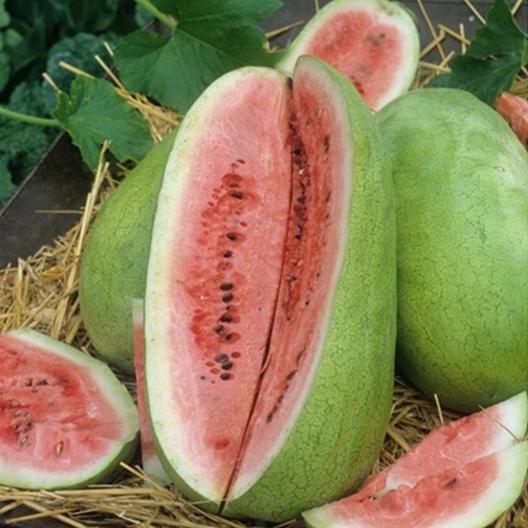
Watermelons grow best in warm weather and sandy soils. Make sure their trailing vines have plenty of space and let your melons enjoy the warm summer sun for delicious, sweet harvests!
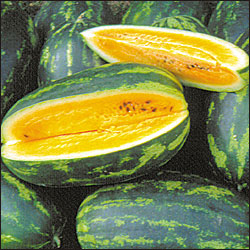
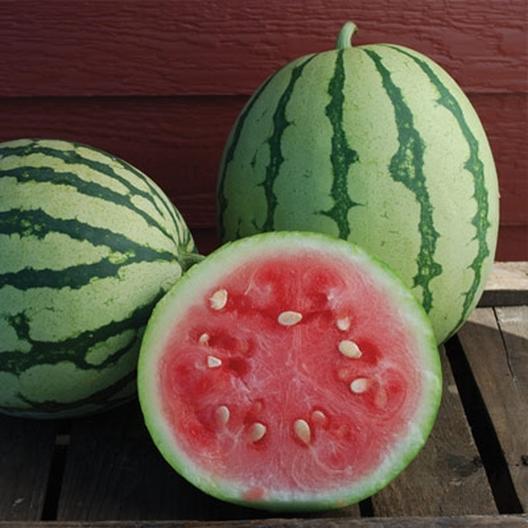
A round to oblong variety, Dixie Queen is an excellent choice for an early season watermelon. The plant produces good yields of 40 lb watermelons. It has exceptionally sweet crisp red flesh. Want an early harvest, then you have to try this variety. An excellent choice for home gardens and Farmer’s Markets. 75 days.
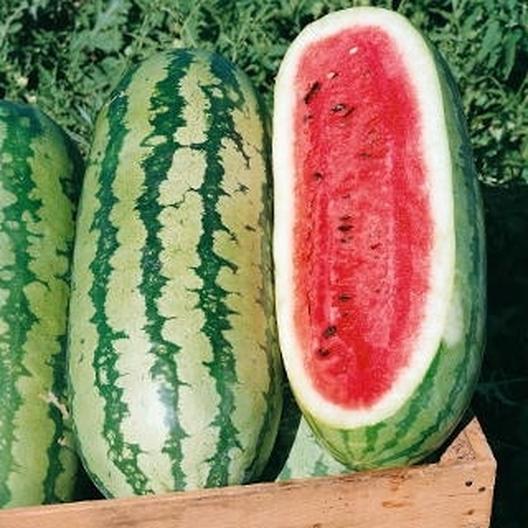
The large, oval fruits average 25-45 lbs. and some can grow as large as 75 lbs. The fruits are as beautiful inside as they are on the outside. They have a sweet, firm, bright rose flesh and beautifully patterned light and dark green rattlesnake markings on their skins. The skins are thick, so they hold up well for shipping, storage or taking to a picnic The rind is thin but very tough, which made it a favorite of market gardeners. 90 days.
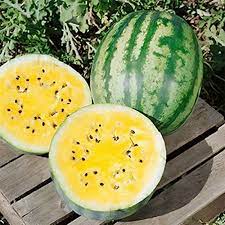


An heirloom, heat tolerant, seeded, picnic watermelon. Suitable for growing in garden plots. Resistant to Anthracnose (1), Fusarium Wilt (Race 0). All Sweet is a descendant of Crimson Sweet Watermelon and has been around for a long time. Is a high-quality heirloom seed. 30 pound melons.

These large, oblong melons thrive in heat and humidity, making this variety an excellent choice for warmer climates; they also adapt well to various climates, and have become one of the most popular watermelons in the United States.
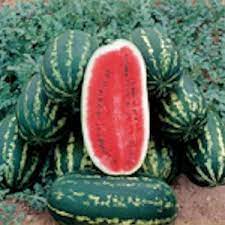



The story of Orangeglo watermelon goes back to the 1960s in Poolville, Texas, where it was developed by the Willhite Seed Company, which is well-known for its many varieties of watermelon. Over the years, Orangeglo has proved itself through its huge popularity with small growers, and remains, hands down, one of the best-tasting of all the orange-yellow varieties. With rich, pumpkin-colored flesh, this orange watermelon possesses one of the fruitiest of aromas and a sorbetlike texture that makes it excellent for frozen desserts. Many watermelons turn bland and insipid when frozen, but not Orangeglo! 85 days.
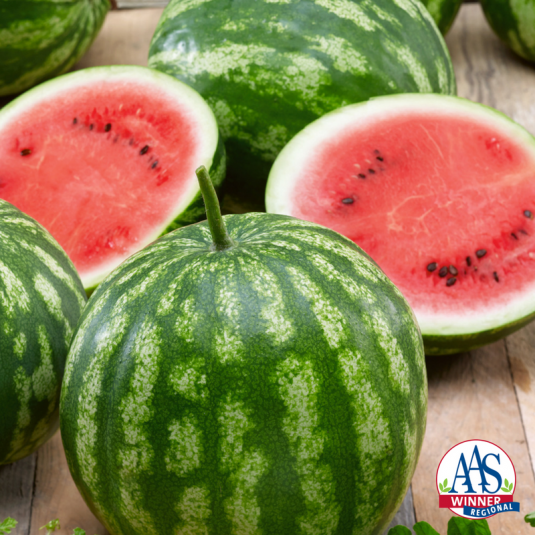

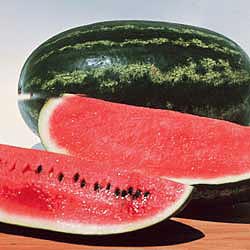
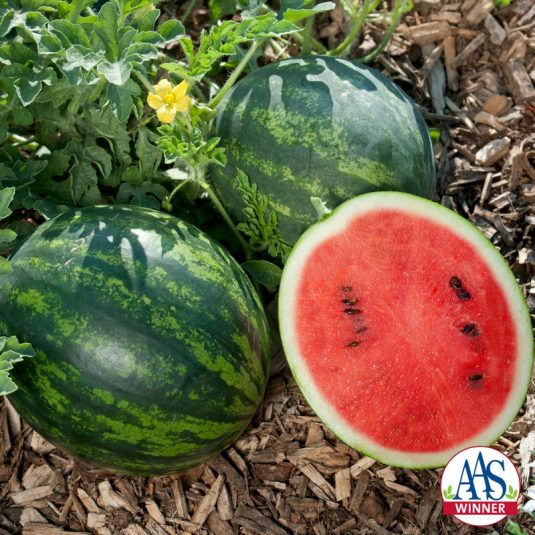
This personal-sized Asian watermelon is perfect for smaller families and smaller gardens. Shorter vines (3-4 feet) still produce up to six fruits per plant and can be grown in smaller spaces. Several judges commented on the crack and split resistant rinds, important for reducing crop loss.
For culinary purposes, this deep red fleshed watermelon has a thin but strong rind that can be carved into attractive shapes for fruit salad presentations. Mini Love has a high sugar content resulting in sweet and crisp, juicy flesh that will be a true summer delight for watermelon lovers.
Matures in 70 days.
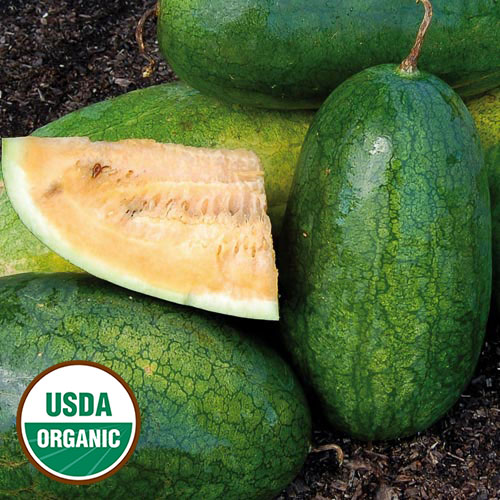
The 1937 McFayden Seed catalogue wrote "Largest of the Early Strains. A very early yellow fleshed variety extensively grown by Russians. It is supposed to have come from Siberia.
The melons are oblong, dark green, borne abundantly on vigorous vines. The flesh is a golden yellow, sweet and delicious. Grown extensively by Hutterite Colonies, who find ready sale for them in many districts of Manitoba. (80 days).
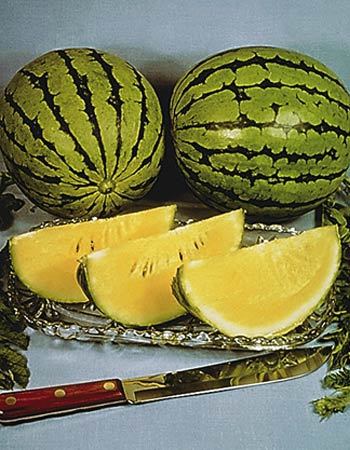
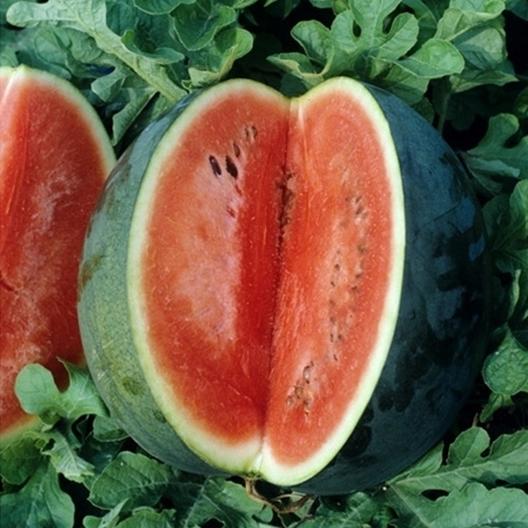
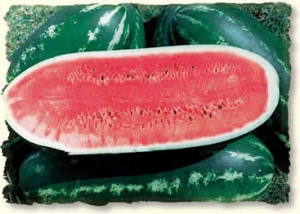
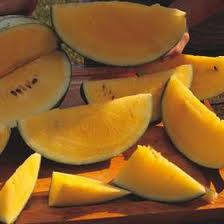
The heirloom watermelon Yellow Crimson is nearly identical to the red-fleshed Crimson Sweet. Rather than being the result of hybrids, yellow and white varieties of watermelon are actually more ancient than their pink and red counterparts. Historians believe that the yellow versions grew wild in South Africa originally.
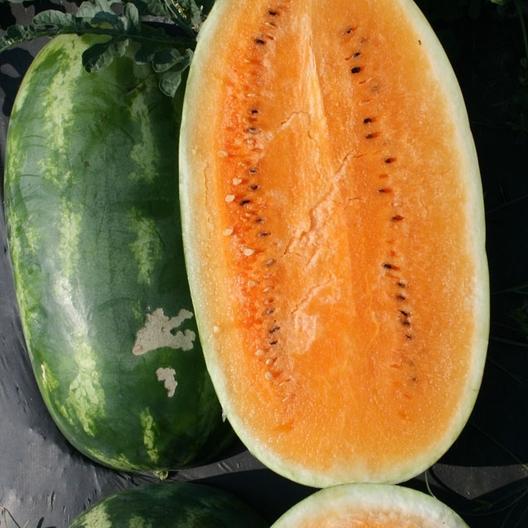
These oblong watermelons are both lovely and delicious. The strong rinds and sweet orange flesh with high sugar content make these a favorite for many. They grow about 18" long and weigh about 35 pounds when they reach maturity after 95 days of growing. These seeds are so popular that they are often sold out!
Tendersweet Orange, an extremely sweet watermelon of the orange fleshed type, is distinguished from other orange varieties because of its unusually strong rind; this makes it a good shipping melon. Rather than being the result of hybrids, yellow and orange varieties of watermelon are actually more ancient than their pink and red counterparts.
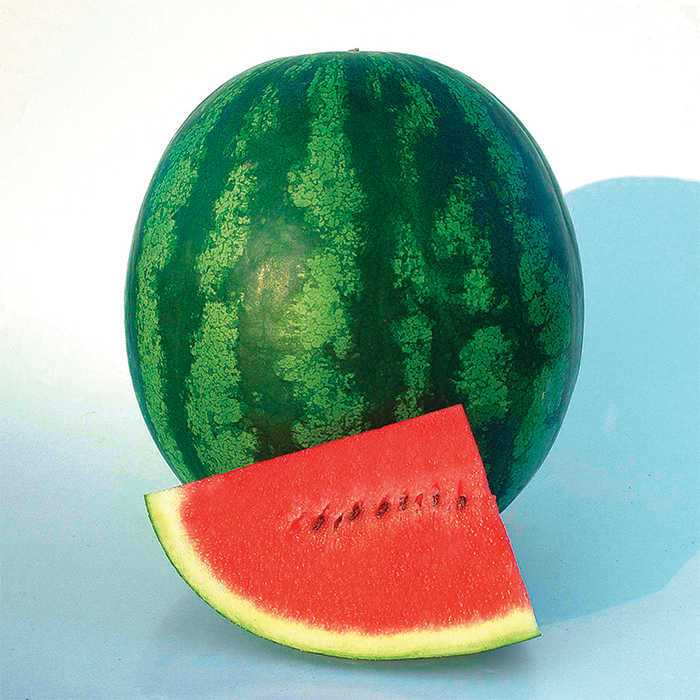
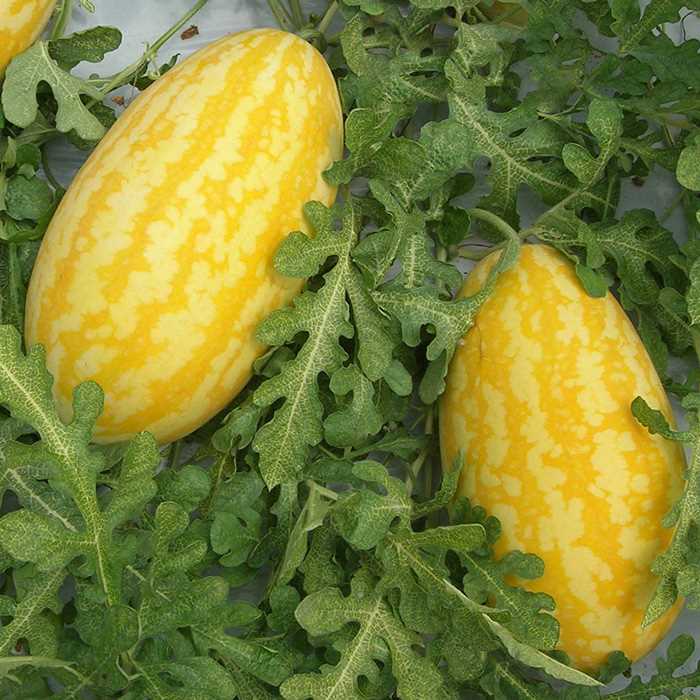

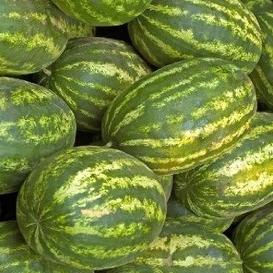

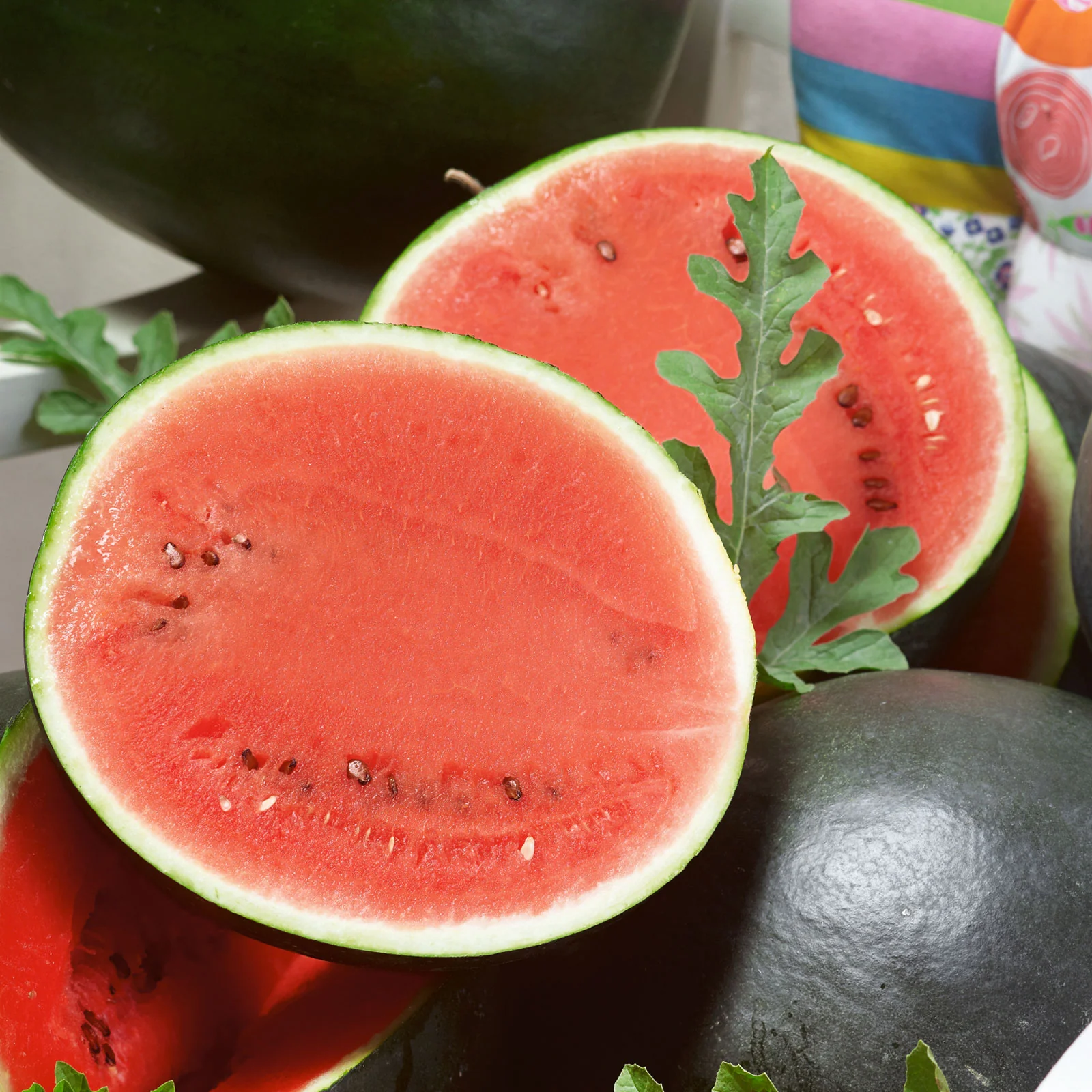
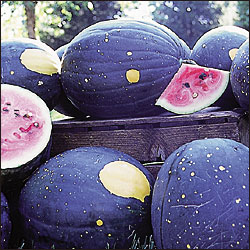
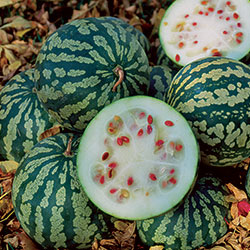
This variety has vivid red seeds and a light green rind with dark green stripes. Fruits can be stored for up to a year. Extremely productive, drought tolerant, and resilient. 90-100 days.
Click here for Citron Melon Recipes
Seedless Watermelons
The seedless watermelon is now a reality. Seedless watermelons--sweet inside but without the numerous seeds found in conventional watermelons--are the ultimate in convenience foods.
Seed Production. The obvious question asked about growing seedless watermelons is: "How does one obtain seed of a seedless watermelon?" Obviously, you cannot save seed from a seedless watermelon. So, where do the seeds come from? Simply stated, the number of chromosomes (the threadlike bodies within cells that contain the inheritance units called genes) in a normal watermelon plant is doubled by the use of the chemical colchicine. Doubling a normal (diploid) watermelon results in a tetraploid plant (one having four sets of chromosomes).
When the tetraploid plant is bred back, or pollinated, by a diploid or normal plant, the resulting seed produces a triploid plant that is basically a "mule" of the plant kingdom, and it produces seedless watermelons. Seed of seedless varieties are available from most major seed companies.
General Climatic Requirements. Seedless watermelons are a warm-season crop, preferring relatively high temperatures for optimum growth. Daytime temperatures of 80 to 95 degrees F. and night temperatures of 60 to 70 degrees F. are best. When temperatures are lower, plant growth is slowed considerably. With favorable weather, seeded fields can produce ripe fruit in 85 to 100 days.
Planting: Poor seed germination is the main problem with growing seedless watermelons. When direct seeding, the soil temperature should be minimum of 70 degrees F. at a depth of 4 inches. Soil temperatures below 70 degree F. will reduce germination and emergence. When growing transplants, use 12- to 2-inch seedling cells or peat pellets. Soak the planting medium thoroughly, and let drain 4 to 6 hours before sowing. Plant 1 or 2 seeds per cell or pellet. The greenhouse temperature should be 75 to 85 degrees F. during the germination period. Do not allow the growing medium to become dry, but do not over water during initial germination. Begin watering, as needed, after 10 to 15 percent of the seedlings have emerged. Plants should be ready for transplanting in 3 to 4 weeks. Transplants should have not more than 3 true leaves when set in the field. Use of older, larger transplants can cause slow, stunted growth and poor yields. In-row and between-row spacing is generally 48 X 80 inches.
Pollination. The male and female flowers are born separately on the watermelon plant. Female flowers must be pollinated for fruit to set. Also, cross pollination must occur between a seedless and a regular type watermelon for seedless fruit to be produced. This is best accomplished by planting a standard watermelon variety in the garden. Approximately one-third of the plants in the garden should be of the standard or 'pollinator' variety. Honey bees are the principal insects that pollinate watermelons. Pollination is a must, and poor or partial pollination may result in misshapen fruit and no seedless melons.
Harvesting. The lower side or 'ground spot' of the fruit should be cream-colored or yellowish. Thump fruit to check for ripeness. The result will vary. Generally, a solid sound indicates ripeness, while a sharp echoing sound indicates a greener fruit. The tendril or 'tail' which occurs in the axils of leaves (where the leaf attaches to the vine) along the stem can be used as an indicator of ripeness. Experienced harvesters say that if the 2 tendrils nearest the fruit are dry, the seedless watermelon is ripe. It is important to note that the first few mature melons in the garden may frequently contain small seeds. This condition is most prevalent under stressed conditions, such as low soil moisture, insufficient fertilizer, temperature extremes, or disease pressure, which affect normal plant development. Each planting of seedless watermelons actually produces 3 different types of watermelons -- the regular seeded watermelons (from pollinator plants), the true seedless melons, and a light-green tetraploid melon that produces a very limited number of seeds, from which next year's planting can be made.

